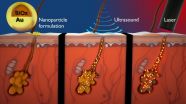ACS, the world's largest scientific society, is holding the meeting here through Thursday. It features nearly 11,000 presentations.
"This disease has gone on for over three decades," says Dennis Liotta, Ph.D. "We've got to try to find new solutions. Even with the 30 approved drugs that we have, and even when you completely suppress viral replication, we still see disease progression."
So Liotta's team at Emory University decided to tackle a seemingly intractable problem that had been plaguing efforts to defeat the virus.
To replicate, Liotta explains, HIV fuses with human immune cells by interacting with key proteins. Its genetic contents subsequently spill inside the immune cells, and the viral proteins then hijack the cellular machinery to make copies of themselves.
One drug company (Pfizer) has developed a compound that blocks HIV's interaction with one of those proteins, a co-receptor called CCR5. But the virus can also use a second co-receptor, CXCR4, to enter cells. If a drug targets just CCR5, a more virulent strain that favors CXCR4 could emerge over time, says Liotta.
In theory, drugs targeting CXCR4 would be an effective addition to the arsenal against HIV. But interfering with that protein, which regulates several of the body's inflammatory responses, could lead to serious side effects.
"With a chronic infection like HIV, it's very challenging to take a drug every day of your life if you have significant side effects," Liotta says. "This is a very high bar. No drug that functions as a CXCR4 antagonist for HIV has gotten over that bar."
Liotta's team decided to search for compounds that might be able to bind both CCR5 and CXCR4 at the same time, while avoiding serious side effects.
"Essentially, we took a step back and said instead of creating yet another cocktail of multiple drugs to stop the different mechanisms of HIV, we thought we could design one that hit multiple targets at once," says Anthony Prosser, a graduate student in Liotta's lab. If a new drug could block HIV entry by interfering with CCR5 and CXCR4, it could be paired with a traditional cocktail targeting other stages of the virus lifecycle for an even more robust treatment.
Prosser came up with a simple, inexpensive method to synthesize compounds that likely would bind both co-receptors. Lab tests identified the most effective ones, and the group's partners at pharmaceutical company Bristol-Myers Squibb found that the compounds also blocked HIV reverse transcriptase, an enzyme that's key to the virus's ability to copy itself.
"The agents were active against CCR5, CXCR4 and HIV reverse transcriptase," Liotta says. "That was unprecedented. Also, they don't perturb any of the CXCR4 signaling pathways that lead to inflammation."
An additional benefit of this approach is that the compounds target proteins on human cells. Most HIV drugs target viral proteins, but because they often mutate when exposed to antiretroviral agents, resistance can develop quickly. When that happens, patients have to switch to a new drug combination that can be less effective than the previous treatment. Human proteins rarely mutate to a significant extent, so HIV will be far less likely get around drug combination therapies that include a CXCR4/CCR5 inhibitor, Liotta explains. Since these agents are inexpensive to prepare, they could potentially keep treatment affordable for millions, particularly in the developing world.
Now the lab is working to further control the activity of these compounds, boost their potency and minimize their potential toxicity.
"We've got a long way to go, but this is a very exciting finding," Liotta says.
INFORMATION:
A press conference on this topic will be held Monday, March 23, at 3 p.m. Mountain time in the Colorado Convention Center. Reporters may check-in at Room 104 in person, or watch live on YouTube http://bit.ly/ACSLiveDenver. To ask questions, sign in with a Google account.
The work was funded by Liotta's earlier work on HIV drug emtricitabine that resulted in a sale by Emory University to Gilead Sciences.
The American Chemical Society is a nonprofit organization chartered by the U.S. Congress. With more than 158,000 members, ACS is the world's largest scientific society and a global leader in providing access to chemistry-related research through its multiple databases, peer-reviewed journals and scientific conferences. Its main offices are in Washington, D.C., and Columbus, Ohio.
To automatically receive news releases from the American Chemical Society, contact newsroom@acs.org.
Note to journalists: Please report that this research is being presented at a meeting of the American Chemical Society.
Follow us: Twitter | Facebook
Title
Discovery and synthesis of first-generation single-drug "cocktails" to combat HIV
Abstract
Current HIV regimens require at least three antiviral drugs to arrest ongoing viral replication and restore immune function. Unfortunately, these so-called "drug cocktails" come with significant financial burden, a continually emerging set of long term side effects, and the potential for resistance if not taken as prescribed. Resistance develops due to the plasticity of the viral genome which is able to produce several isoforms of the protein that are targeted by antiretroviral therapy. Thus, it would be advantageous to target specific host proteins which exist as a single isoform and are not significantly responsive to selective pressures. Of particular interest are the chemokines CCR5 and CXCR4, which are required for HIV cellular entry. Unfortunately, inhibition of CCR5 facilitates viral evolution toward CXCR4 entry and vice versa. Therefore, it is necessary to inhibit both chemokines simultaneously to completely blockade HIV. We have discovered and synthesized a novel series of small molecules that demonstrate potent anti-HIV activity against both R5 and X4 tropic viral strains that specifically bind both co-receptors at once with minimal impact on cellular signaling. Additionally these molecules have been shown serendipitously to be potent inhibitors of HIV reverse transcriptase. These three complementary methods of action may yield a single drug therapy for HIV. The discovery, synthesis, SAR, and unique biological profile for these molecules will be discussed.
Due to a premature posting of this release, the embargo is now lifted as of March 19. END


